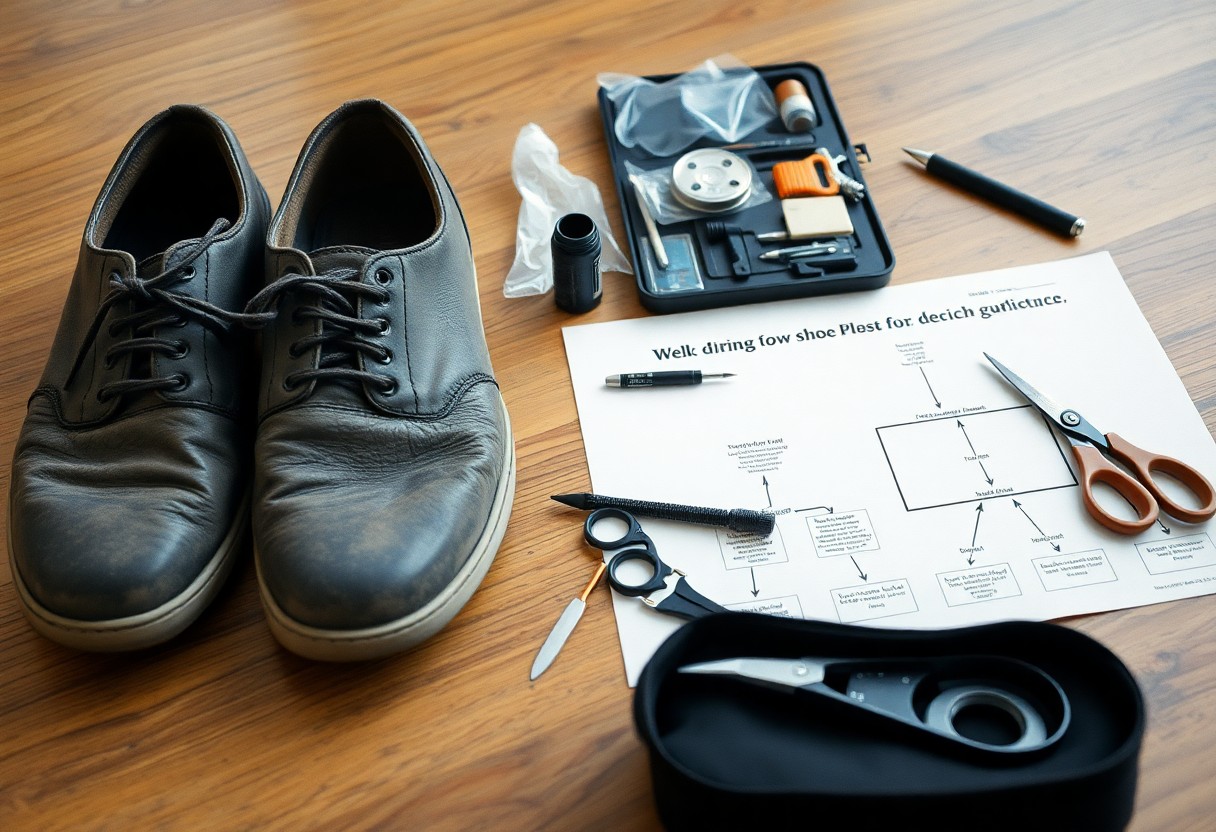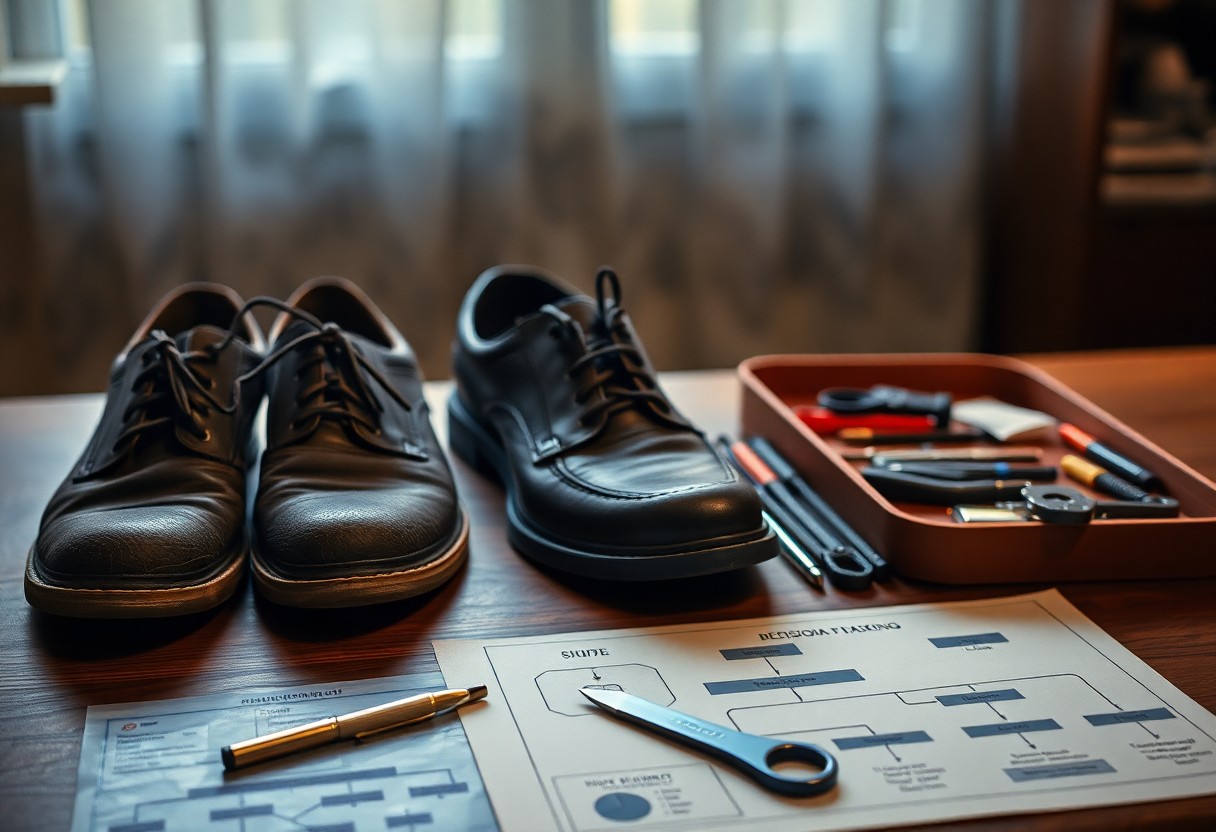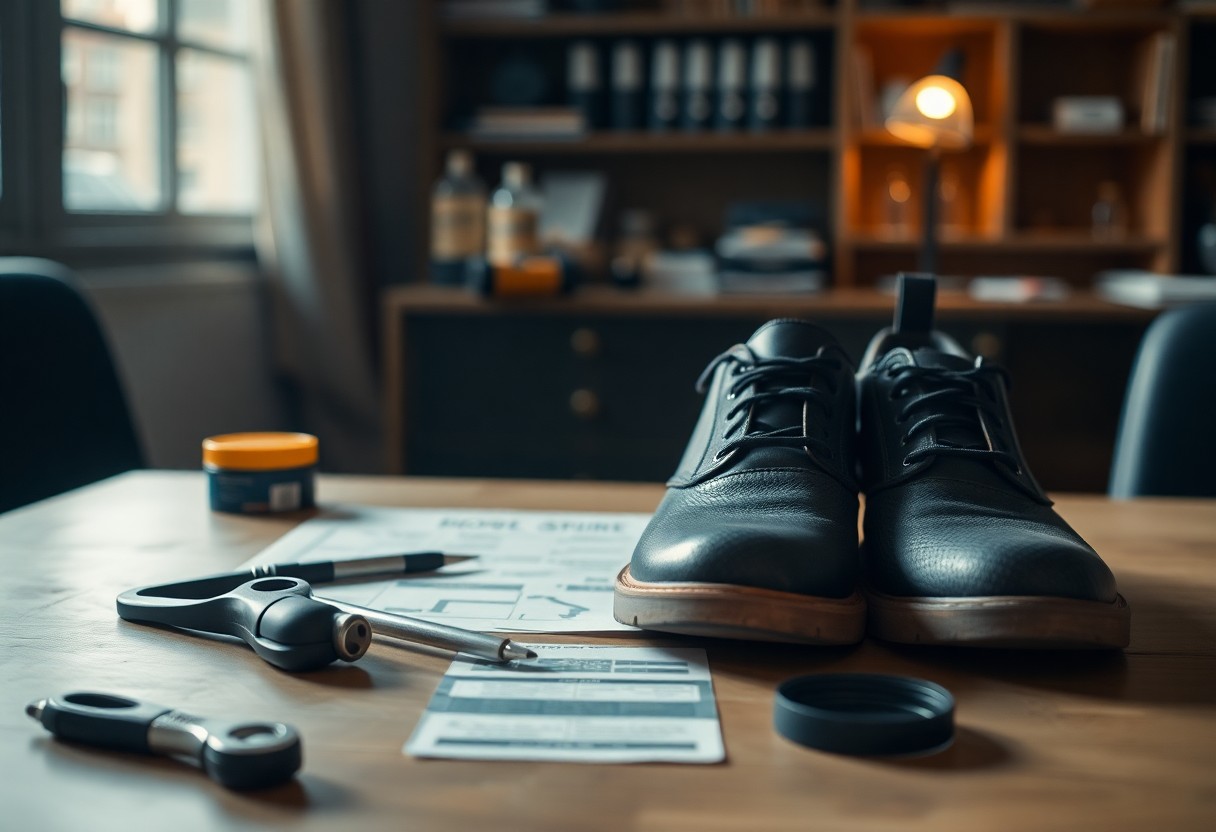
This comprehensive guide is crafted to empower you to make smart and financially sound decisions about your footwear. When confronted with worn-out shoes, the dilemma between repairing or replacing them can significantly affect your budget while also prolonging the lifespan of your favorite footwear. Your choice should depend on several vital factors, including the initial quality of your shoes, the extent of the damage, and the repair costs involved. For example, if you own high-quality leather shoes with sole wear or heel damage, opting for repairs might be a practical and cost-effective approach. However, if the upper leather is severely damaged or there are multiple structural issues, a replacement may be necessary. By understanding these essential considerations, you can maintain your footwear effectively while making savvy financial choices.

Discover the Most Common Types of Shoe Damage and Their Solutions
Before deciding whether to repair or replace your shoes, it’s crucial to familiarize yourself with the various types of damage that can affect your beloved footwear. Shoes can sustain damage in several key areas, including soles, heels, uppers, and structural components. Early recognition of these issues can dramatically improve your ability to make informed choices regarding the necessary repairs for your shoes.
| Damage Type | Repair Possibility |
| Sole Wear | Usually repairable |
| Heel Damage | Highly repairable |
| Upper Leather Cracks | Limited repair options |
| Structural Issues | Case-dependent |
| Cosmetic Damage | Mostly repairable |
Proactively Address Sole and Heel Issues for Enhanced Longevity
The soles of your shoes often exhibit the first signs of wear, with heel deterioration being one of the most common problems. It is essential to give immediate attention to your shoes when you notice uneven wear patterns or frayed edges on the heels. Tackling these concerns promptly not only prevents further damage but also improves the overall comfort of your footwear, enhancing your daily walking experience.
Identify Upper Leather Problems and Their Consequences
For leather shoe owners, encountering issues such as creasing, cracking, and scratches is commonplace. These problems often arise from daily use and lack of proper care. It’s important to understand that the severity of leather damage can differ greatly. Some shoes may display only surface scratches that can be relatively easy to resolve, while others may develop deeper cracks that complicate the repair process and require more extensive interventions.
Comprehend the Implications of Structural Damage on Footwear
Common structural problems in shoes include separated soles, broken shanks, and damaged welts. The structural integrity of your shoes has a direct impact on both their comfort and safety. Repairs to these structural components usually require professional intervention. A skilled cobbler can determine whether the damage is repairable or if replacement would be the more prudent route, ensuring your footwear remains safe and functional.
Revamp Your Shoes by Addressing Cosmetic Damage
Surface scuffs, fading colors, and minor scratches all fall under the category of cosmetic damage. Thankfully, these issues can often be remedied with the right care and treatment. Cosmetic repairs are typically among the most cost-effective solutions available for shoe maintenance. Through professional cleaning and refinishing services, your shoes can regain their aesthetic appeal, making them look nearly new again while saving you the costs associated with purchasing new footwear.

Evaluate Key Factors Before Choosing Repairs or New Shoes
Before making a decision regarding whether to repair or replace your shoes, it is vital to assess several critical factors. This assessment should include the age and condition of the shoes, a comparison of repair costs against the price of new shoes, the quality of materials, and any personal attachment you might have to the footwear. Each decision should blend practical considerations with the economic implications of your choice.
- Overall condition assessment
- Cost comparison
- Material quality check
- Sentimental value evaluation
Thoroughly Assess the Age and Overall Condition of Your Shoes
If your shoes are relatively new—say less than two years old—and show minimal wear aside from sole or heel damage, repairs are often a worthwhile option. Examine the upper materials for cracks, assess the condition of the insoles, and scrutinize the stitching integrity to ensure your footwear is still in good shape. By doing so, you can enhance the chances of successful repairs and extend the life of your favorite shoes.
Compare Costs: Repairing Shoes Versus Buying New Footwear
| Basic Repairs | €15-60 |
| Major Repairs | €70-200 |
| New Quality Shoes | €200-500 |
As a general guideline, repair costs should not exceed 50% of the price of new shoes for the decision to be economically viable. This benchmark is crucial to keep in mind when weighing your options, ensuring you make a financially sound choice.
| Heel Replacement | €15-30 |
| Half Sole Repair | €70-120 |
| Full Sole Repair | €130-200 |
| Heel Lining | €25-60 |
Evaluate Shoe Quality and Material Durability for Better Decisions
The type of construction and the quality of materials used in your shoes are critical factors to consider during your decision-making process. Welted shoes made from full-grain leather are generally more amenable to repairs compared to cemented shoes crafted from synthetic materials. The repairability of a shoe is often directly linked to how it was constructed, influencing how much wear and tear it can withstand.
High-quality welted shoes can typically endure multiple repairs, while cheaper cemented constructions may not justify the effort or expense of fixing them. Understanding the materials and construction methods used will guide you in making more informed choices about your footwear’s longevity.
Assessing Sentimental Value in Your Footwear Repair Choices
Even shoes that have seen better days may be worth repairing if they hold special significance or are rare vintage finds that you cherish. The comfort level, perfect fit, and emotional attachment to the footwear can justify higher repair costs. As you weigh the practical aspects of your decision, be sure to consider these personal values that can significantly influence your choice.
Determine the Right Moments to Repair Your Shoes
Your decision to repair shoes should be guided by their overall condition and intrinsic value. If your footwear showcases quality leather uppers and has a solid construction, repairs can greatly extend their functional lifespan. Consider undertaking repairs when the damage is limited to specific areas, such as soles or heels, while the overall structural integrity remains intact, ensuring you get the best value for your investment.
Identifying Repairable Conditions in Your Footwear
There are numerous fixable issues that indicate your shoes are worth repairing, such as worn soles, damaged heels, loose stitching, and minor leather scuffs. Your shoes are excellent candidates for repair if the upper leather remains intact and the insole exhibits no signs of cracking. Basic repair costs typically range from $15-60, making them a financially appealing option for maintaining your footwear.
Understanding Cost-Effective Repair Scenarios for Your Shoes
The optimal moment to repair your shoes is when the repair cost is less than 50% of the price of new shoes. High-quality leather shoes, especially those with welted constructions, are generally worth repairing, particularly when basic resoling ($70-120) is significantly less than purchasing new high-quality footwear. Conditions that make repairs worthwhile include high-quality construction, minimal wear on the upper portions, and damage confined to easily replaceable components.
Ensure that your shoes have uncracked upper leather and intact insoles to justify repair costs ranging from $25 for heel replacement to $200 for full sole repairs. This way, you can maximize the lifespan of your footwear while keeping costs manageable.
Anticipating the Benefits of Professional Repairs for Longevity
With properly executed repairs, you can expect restored functionality and a significantly extended lifespan of your shoes. Well-repaired footwear can offer several additional years of wear, particularly with quality resoling or heel replacement work. The expected longevity of repairs can vary based on the type performed: heel replacements may last anywhere from 6 months to 2 years, while resoled shoes can provide an additional 2-5 years of service with proper care. Your repaired shoes should feel comfortable and stable, maintaining their original fit and support throughout their extended lifespan.
Recognizing When It's Necessary to Purchase New Shoes
It becomes imperative to replace your footwear when repair costs exceed 50% of the price of new shoes, or when significant structural damage makes repairs impractical. Warning signs include severe cracks in the upper leather, compromised insoles, or multiple repair needs that arise simultaneously, indicating that the cost of upkeep may outweigh the benefits of attempting to repair.
Identifying Situations That Are Beyond Repair
Certain types of damage are irreparable, and recognizing them is crucial. Be vigilant for deep cracks in multiple areas of the upper leather, severely damaged insoles, or widespread structural failures. When you observe these issues, it’s wise to begin shopping for replacements instead, ensuring you have safe and functional footwear.
Analyzing Economic Considerations for Repair Versus Replacement
Not all repairs are created equal from a financial perspective. Basic repairs, such as heel replacements (€15-30) and sole repairs (€70-120), can be economical choices for maintaining quality shoes. However, if multiple repairs are needed at once, it may signal that it’s time to consider new shoes. Given that quality welted shoes typically range from €200-500, comparing repair costs to the original price is essential. If the cumulative repair costs exceed half the price of new shoes, purchasing new footwear usually becomes the more sensible financial option.
Prioritizing Safety Concerns When Assessing Footwear Conditions
Worn-out shoes can pose a serious risk of foot injuries and accidents. Warning signs such as completely smooth soles, exposed steel toe caps, or compromised water resistance indicate that your shoes no longer provide adequate protection. Safety considerations should include your working environment; if you work in hazardous conditions or require specific safety features, even minor structural damage can render your shoes unsafe. It is essential not to compromise your safety by wearing damaged footwear.

Your Systematic Step-by-Step Assessment Guide for Footwear
To keep your shoe evaluation organized and efficient, follow this systematic approach to determine whether to repair or replace your shoes. This guide will help you navigate the process smoothly and ensure you consider all relevant factors.
| Repair Indicators | Replacement Indicators |
| Worn soles (no welt damage) | Cracked insoles |
| Heel wear (surface only) | Multiple upper cracks |
| Minor scratches | Severe structural damage |
Conducting a Thorough Damage Evaluation for Informed Decisions
The first step in assessing your shoes is to examine them in adequate lighting. Look closely at the soles, heels, upper leather, and insoles for any signs of wear. A half sole replacement typically costs between €70-120, while a full sole repair can range from €130-200. Being informed about the potential costs can aid in your decision-making process.
- Sole integrity check
- Upper leather inspection
- Heel stability assessment
- Insole condition evaluation
Maximizing Professional Consultation for Optimal Repair Outcomes
Seeking damage assessment from a qualified professional can greatly enhance your ability to make informed decisions regarding your shoes’ future. Here are essential tips to keep in mind:
- Obtain multiple opinions if necessary
- Inquire about repair costs upfront
- Request timeline estimates for the repair process
- Compare repair estimates with new shoe prices
When visiting a cobbler, it is advisable to bring both shoes for a comprehensive assessment. Document any specific issues you’ve encountered and inquire about warranty coverage for the proposed repairs. Understanding that a professional evaluation typically costs between €15-30 can aid in budgeting for this service.
Exploring Professional Repair Options for Your Footwear
To prolong the life of your shoes, utilizing professional repair services can provide specialized solutions for various shoe-related issues. Local cobblers are equipped to handle everything from basic resoling to complex leather repairs, often at a fraction—30-50%—of the cost of purchasing new shoes. The decision to repair ultimately hinges on the shoe's quality and the extent of the damage, allowing you to make informed choices that align with your footwear needs.
Discovering the Various Types of Shoe Repair Services Available
| Service | Average Cost |
|---|---|
| Heel Replacement | $15-30 |
| Full Sole Replacement | $50-70 |
| Leather Patching | $20-40 |
| Stitching Repair | $10-25 |
| Stretching | $15-20 |
- Resoling – Complete sole replacement
- Heel repair – Replacing worn heel tips
- Leather work – Patching and restoration
- Stretching – Adjusting shoes for size
Finding a Qualified Cobbler for Your Repair Needs
When looking for a reliable shoe repair professional, prioritize certified cobblers with positive customer reviews and at least five years of experience. The best options typically include shoe repair shops equipped with specialized tools and a proven track record in dealing with your specific type of footwear. By doing thorough research, you can ensure your shoes receive the best possible care.
For instance, you can verify a cobbler’s credentials by checking their certification from the Shoe Service Institute of America, assessing the cleanliness of their workshop, and asking to see examples of their previous repair work. Local shoe stores often have partnerships with trusted repair professionals and can provide reliable recommendations, making it easier for you to find a suitable cobbler.
Make Informed Choices for Your Footwear Maintenance
With the information provided, you now have the tools to make better decisions about whether to repair or replace your shoes. Shoes are generally repairable when the damage is limited to the soles, heels, buckles, or surface scratches. Conversely, consider purchasing new footwear when you identify cracks in the upper leather or insole, as these repairs often come at a higher cost than replacement and rarely yield satisfactory results. The key lies in maintaining your shoes properly and addressing repairs promptly. By carefully weighing repair costs against the shoe’s overall value and condition, you can extend the life of your footwear while also saving money in the long run.
Your Frequently Asked Questions Answered
Q: How can I determine if my shoes are worth repairing or if I should buy new ones?
A: Evaluate the following key factors: If your shoes feature high-quality leather uppers without cracks and only require repairs to the soles or heels, then repairs are advisable. The total repair cost should be less than 50% of the price of new shoes. Basic repairs such as heel replacements ($20-35) and resoling ($70-120) are typically sensible for quality shoes. If the upper leather shows cracks, the insole is damaged, or repairs exceed half the price of new footwear, consider purchasing new shoes.
Q: Which shoe repairs provide the best value for the cost?
A: The most cost-effective repairs include heel replacements ($20-35), heel lining repairs ($25-60), and simple regluing of separated parts ($10-20). These repairs can significantly extend the lifespan of your shoes at a minimal expense. Half-sole replacements ($70-120) also present good value for quality welted shoes. It’s crucial not to delay necessary repairs, as this can lead to more expensive damage that may ultimately require complete shoe replacement.
Q: What types of shoe damage are generally irreparable?
A: There are three primary types of damage that make repairs impractical: 1. Deep cracks in the upper leather, particularly in creasing areas 2. Structural cracks in the insole 3. Multiple significant damages that would require repair costs exceeding the price of new shoes. These issues compromise the fundamental structure of the shoe, and repairs often yield unsatisfactory results. In such cases, purchasing new shoes is typically the better alternative.
The Article Guide on deciding when to repair shoes versus buying new practical tips for making the right choice appeared first on My Shoes Finder
The Article Deciding to Repair Shoes or Buy New: Essential Tips Was Found On https://limitsofstrategy.com


This is such a timely and relevant discussion! I’ve had my share of battles between repairing beloved shoes and biting the bullet on a new pair. A couple of years ago, I invested in high-quality leather boots that have become a staple in my wardrobe. When the soles started to wear down, I faced that same dilemma you described. I opted for repairs, and honestly, it felt great to give them a second life while still saving money compared to buying a new pair.
It’s interesting how something as simple as a pair of shoes can lead us down a path of thoughtful choices, isn’t it? That tug-of-war between keeping something you love and the lure of a shiny new replacement is one many of us can relate to. Your experience with the leather boots really highlights how investing in quality can pay off long-term.
“I’m so glad to hear about your great experience with shoe repair! If you’re interested in learning more about ways to breathe new life into your favorite footwear, check out this helpful guide!”
https://mannland5.com/webilaro
It’s fascinating to think about how our footwear choices can reflect broader values like sustainability and personal finance. I recently faced a similar dilemma with a beloved pair of running shoes that had seen better days. Initially, I leaned towards replacing them completely, but I decided to get them repaired instead after realizing how much I appreciated their comfort and fit.
You bring up a really interesting point about the connection between our footwear choices and bigger issues like sustainability and personal finance. It’s like a ripple effect—what we choose to wear can say a lot about how we value both our resources and the environment.